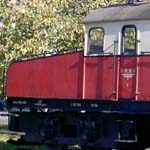 The history of the Karlsruhe Model is directly connected to the special history of the
Albtal-Verkehrs-Gesellschaft mbH (AVG). The AVG arose from
the Albtalbahn,
a private railway company which has since 1897 operated in the region,
carrying passengers from Karlsruhe to Bad Herrenalb in the Black
Forest. The narrow-gauge Albtalbahn was in operation until the
1950s. The Albtalbahn line terminated at the Albtalbahnhof, which
used to be located near the first Karlsruhe main station at Kriegsstrasse. The Karlsruhe Hauptbahnhof was relocated in 1913, and soon thereafter in 1915 the Albtalbahnhof was also relocated.
The history of the Karlsruhe Model is directly connected to the special history of the
Albtal-Verkehrs-Gesellschaft mbH (AVG). The AVG arose from
the Albtalbahn,
a private railway company which has since 1897 operated in the region,
carrying passengers from Karlsruhe to Bad Herrenalb in the Black
Forest. The narrow-gauge Albtalbahn was in operation until the
1950s. The Albtalbahn line terminated at the Albtalbahnhof, which
used to be located near the first Karlsruhe main station at Kriegsstrasse. The Karlsruhe Hauptbahnhof was relocated in 1913, and soon thereafter in 1915 the Albtalbahnhof was also relocated.
 By the 1950s, the Albtalbahn encountered increased economic
difficulty. One cause for its troubles was the location of its
bahnhof outside of the center of the city. To prevent its
impending economic ruin, the Albtalbahn needed operational
restructuring. Deutsche Bundesbahn, the state railway of former
West Germany, refused to assimilate the Albtalbahn into the national
rail operations. Deutsche Bundesbahn also refused to substitute
buses for the railway line from Bad Herrenalb to Karlsruhe, with the
reason that bus services were not sufficient to carry the potentially
great number of passengers along the line.
The solution to the problem was to connect the tramway network and
the Albtalbahn so that it could operate with tramway vehicles on heavy
railway
infrastructure.
By the 1950s, the Albtalbahn encountered increased economic
difficulty. One cause for its troubles was the location of its
bahnhof outside of the center of the city. To prevent its
impending economic ruin, the Albtalbahn needed operational
restructuring. Deutsche Bundesbahn, the state railway of former
West Germany, refused to assimilate the Albtalbahn into the national
rail operations. Deutsche Bundesbahn also refused to substitute
buses for the railway line from Bad Herrenalb to Karlsruhe, with the
reason that bus services were not sufficient to carry the potentially
great number of passengers along the line.
The solution to the problem was to connect the tramway network and
the Albtalbahn so that it could operate with tramway vehicles on heavy
railway
infrastructure.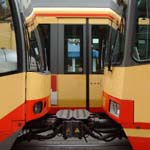
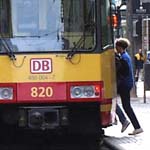
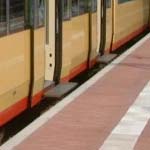
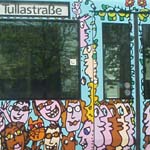 September 25, 1992 was the inauguration of the world's first actual tramtrain line, from Karlsruhe to Bretten. The
September 25, 1992 was the inauguration of the world's first actual tramtrain line, from Karlsruhe to Bretten. The 


